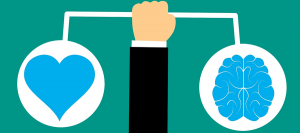
Neurological Basis for SEL
There is a neurological basis for SEL (much of which has been researched using the emotional intelligence framework), which demonstrates that there are distinct areas of the brain that govern our social and emotional skills. These areas of the brain influence the way that we process information, react to emotionally charged events, and demonstrate empathy, among many other components.
For example, research has demonstrated that students are more likely to cognitively engage in tasks when they are more emotionally engaged. So even in perceived “unemotional subjects” such as physics or calculus, having an emotional connection to the content is helpful to learning.
Emotional states influence the degree to which we process information. For example, negative emotional states, such as fear, anger, or anxiety, are linked to less activity in the prefrontal cortex or the part of the brain that is responsible for thinking, whereas positive emotional states are associated with more activity in this area. This is further complicated by the valence or degree of emotion. If students are elated (or in an extremely positive emotional state), then that can hinder processing of information because their focus will be diverted from learning. Conversely, if students have a small degree of anxiety, then this may help them focus their attention.
Therefore, it is important to recognize that our bodies, our minds, and our emotions are interconnected, and attuning to our social and emotional competencies is critical as we engage in learning academic content.
Neuroscience and Adversity
We also know from neuroscience that students who experience adversity in their lives may experience physiological changes that can have short- and long-term consequences for the way that they process information and handle stressors. One goal of SEL programming is to support students, particularly those who experience adverse events, to develop new patterns of connections between areas of the brain that influence emotion and cognition. SEL programming can do this by helping students identify and manage their emotions and identify new patterns of behaviors when they begin to feel stressors. Thus, we know SEL is important for ALL students but also can have the added benefit for those students who experience trauma or prolonged stress.
Videos
Reflection
References
Blair, C., & Raver, C. C. (2015). The neuroscience of SEL. In J. A. Durlak, C. E. Domitrovich, R. P. Weissberg, & T. P. Gullotta (Eds.), Handbook of social and emotional learning: Research and practice (pp. 65-80). New York, NY: Guilfold Press,
Goleman, D. (2011). The brain and emotional intelligence: New insights. Florence, MA: More than Sound.
Lahey, J. (2016). To help students learn, engage the emotions. The New York Times. Retrieved from https://well.blogs.nytimes.com/2016/05/04/to-help-students-learn-engage-the-emotions/?_r=0 (Links to an external site.)
Osher, D., Cantor, P, Berg, J., Steyer, L., & Rose, T. (2017). Science of learning and development: A synthesis. Washington, DC: American Institutes for Research.
